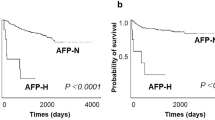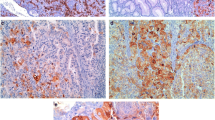Abstract
PURPOSE: The expression of helix pomatia agglutinin in advanced colorectal cancer was evaluated in order to determine whether helix pomatia agglutinin could serve as an effective prognostic indicator. METHODS: Using the histochemical procedure, the expression of helix pomatia agglutinin was studied in 117 patients with primary colorectal cancer. Sixty of 117 patients who died of either recurrence or metastasis within two years (Group 1) after resection were compared with the other 57 patients who survived for five years or longer (Group 2). RESULTS: The helix pomatia agglutinin-positive expression was seen in 34 cases of Group 1 and in only 15 cases of Group 2 (P<0.01). Lymph node metastasis, lymphatic invasion, venous invasion, mucin production, and helix pomatia agglutinin expression all had a significant correlation with the prognosis in the univariate analysis; however, only lymph node metastasis, venous invasion, and helix pomatia agglutinin expression were prognostic factors with a significant difference in the multivariate analysis. CONCLUSIONS: Histochemical expression of helix pomatia agglutinin will indeed aid in accurately predicting the prognosis of patients with advanced colorectal cancer.
Similar content being viewed by others
References
Smets LA, van Beek WB. Carbohydrate of the tumor cell surface. Biochim Biophys Acta 1984;738: 237–49.
Nicholson GL. Cell surface molecules and tumour metastasis. Exp Cell Res 1984;150:3–22.
Altevogt P, Fogel M, Cheingsong-Popov R,et al. Different patterns of lectin binding and cell surface sialylation detected on related high- and low-metastatic tumor lines. Cancer Res 1983;43:5138–44.
Hakomori S. Glycosyphingolipids in cellular interaction, differentiation and oncogenesis. Annu Rev Biochem 1981;50:733–64.
Cooper H. Peanut lectin-binding sites in large bowel carcinoma. Lab Invest 1982;47:383–90.
Carderó J, Campo E, Viñas J, Cardesa A. Lectinbinding sites in neoplastic and non-neoplastic colonic mucosa of 1,2-dimethylhydrazine-treated rats. Lab Invest 1989;61:670–6.
Yonezawa S, Nakamura T, Tanaka S, Sato E. Glycoconjugate with Ulex Europaeus agglutinin-1-binding sites in normal mucosa, adenoma and carcinoma of the human large bowel. J Natl Cancer Inst 1982;69:777–85.
Calderó J, Campo E, Ascaso C,et al. Regional distribution of glycoconjugates in normal, transitional and neoplastic human colonic mucosa. Virchows Arch [A] 1989;415:347–56.
Macartony JC. Lectin histochemistry of galactose andN-acetyl-galactosamine glycoconjugates in normal gastric mucosa and gastric cancer and the relationship with ABO and secretor status. J Pathol 1986;150:135–44.
Sama JS, Lynch HT, Burt R,et al. Abnormalities of lectin histochemistry in familial polyposis coli and hereditary nonpolyposis colorectal cancer. Cancer 1990;66:502–8.
Kakeji Y, Tsujitani S, Mori M,et al. Helix pomatia agglutinin binding activity is a predictor of survival time for patients with gastric carcinoma. Cancer 1991;68:2438–42.
Leathem AJ, Brooks SA. Predictive value of lectin binding on breast-cancer recurrence and survival. Lancet 1987;1:1054–6.
Alam SM, Whitford P, Cushley W,et al. Flow cytometric analysis of cell surface carbohydrate in metastatic human breast cancer. Br J Cancer 1990;2:238–42.
Fukutomi T, Itabashi M, Tsugane S,et al. Prognostic contributions of Helix Pomatia and carcinoembryonic antigens staging using histochemical techniques in breast carcinoma. Jpn J Clin Oncol 1989;19:127–34.
Hermanek P, Sobin LH. TNM classification of malignant tumours. 4th ed. Geneva: Springer-Verlag, 1987:47–9.
Macartony JC. Fucose-containing antigens in normal and neoplastic human gastric mucosa: a comparative study using lectin histochemistry and blood group immunohistochemistry. J Pathol 1987;152:23–30.
Irimura T, Ota DM, Cleary KR. Ulex europeaus agglutinin I-reactive high molecular weight glycoproteins of adenocarcinoma of distal colon and rectum and their possible relationship with metastatic potential. Cancer Res 1987;47:881–9.
Magnani JL, Nilsson B, Brokhaus M,et al. A monoclonal antibody-defined antigen associated with gastrointestinal cancer in a ganglioside containing sialylated lectin-N-fucopentaose II. J Biol Chem 1982;257:14365–9.
Atkinson FB, Ernst SC, Herlyn M,et al. Gastrointestinal cancer-associated antigen in immunoperoxidase assay. Cancer Res 1982;42:4820–3.
Vierbuchen M, Schroder S, Uhlenbruck G,et al. CA50 and CA19-9 antigen expression in normal, hyperplastic and neoplastic thyroid tissue. Lab Invest 1989;60:726–32.
Nanbu Y, Fujii S, Konishi I,et al. Immunohistochemical localizations of CA125, carcinoembryonic antigen, and CA19-9 in normal and neoplastic glandular cells of the uterine cervix. Cancer 1988;62:2580–8.
Ichihara T, Nagura H, Nakao A,et al. Immunohistochemical localization of CA19-9 and CEA in pancreatic carcinoma and associated diseases. Cancer 1988;61:324–33.
Author information
Authors and Affiliations
About this article
Cite this article
Ikeda, Y., Mori, M., Adachi, Y. et al. Prognostic value of the histochemical expression of Helix pomatia agglutinin in advanced colorectal cancer. Dis Colon Rectum 37, 181–184 (1994). https://doi.org/10.1007/BF02047545
Issue Date:
DOI: https://doi.org/10.1007/BF02047545




